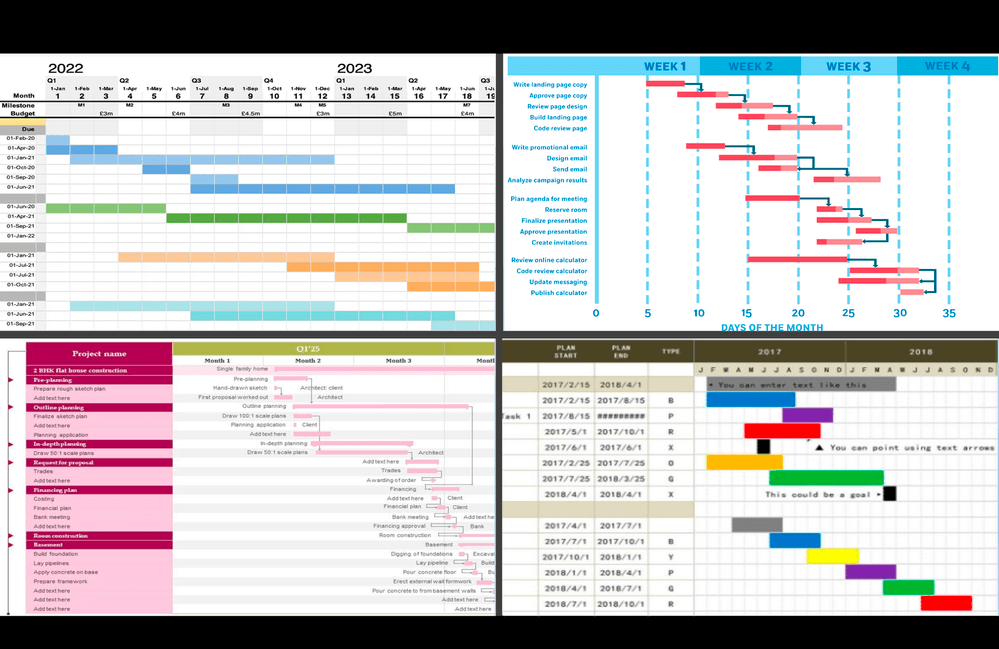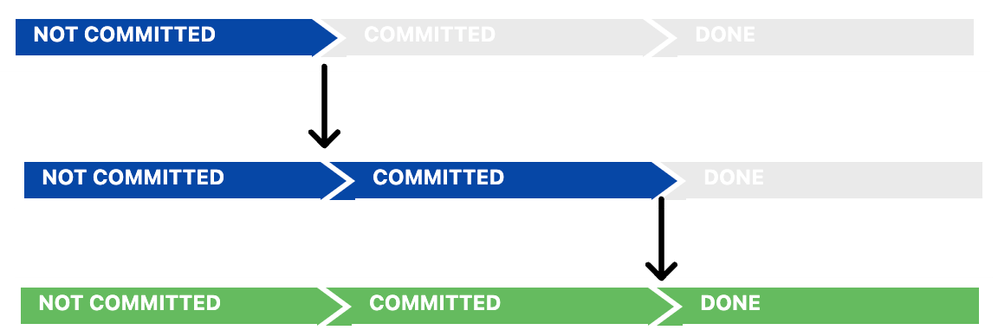What distinguishes an organization following Traditional Project Management from one following an Agile framework? The former operates as a linear system where each project stage is completed sequentially. The latter encourages concurrent work on multiple project stages.

Although the roles differ between traditional project management and Agile ways of working, there are similarities at the portfolio management level. In fact, there are two key steps to Lean Portfolio Management that portfolio leaders can implement, even when teams use different ways of working. Those two key steps are:
- Agility in aligning strategy to execution
- Agility in budgeting
Portfolio leaders mistakenly assume this is out of reach when their teams work in Waterfall, or more commonly, Waterfall-ish. I will demonstrate how portfolio agility can “play nice” with four key aspects of Traditional Project Management:
- Project planning
- Project budgeting
- Dependency and risk
- Objective and key result (OKR)
Project planning
Traditional project planning
We all know, sometimes from painful experience, that a lot of project timelines are spent on planning. Managers must define a clear sequence of execution because the teams complete each stage before moving to the next one. But when the unexpected happens, it is challenging and costly to revisit a previous stage.

Project managers decompose the work into stages, and each stage into tasks and sub-tasks. Each task is often dependent on a previous task, so project managers commonly prefer Gantt charts to help visualize their plan over time (by week, month, quarter, and/or year).

For each stage of a project, the following are the key elements
- Decomposition to tasks
- Who’s working on each task
- Dependency management
- Resource planning
- A timeline of how long each stage will be
- Detailed documentation
- Well-defined duration with start and end date
- Progress tracking

How Jira Align empowers traditional project planning
From project kick-off to closure, Jira Align roadmaps (a Gantt chart view) help to plan and visualize each stage of the project, regardless of each stage’s durations and milestones.
Project planners use Jira Align roadmaps to:
- Plot stages on a monthly, quarterly, or annual basis
- Understand the status of each stage
- Set and track the target start and completion dates per stage

What about the tasks and sub-tasks? Project managers can decompose this view into tasks per stage to understand how work is progressing against plan. Each task shows its duration, start and end dates, and calculates its progress status directly from its own sub-tasks.

With a Gantt chart view for progress tracking, project managers and stakeholders plan the stages and underlying tasks, map key milestones, set multi-level start and end dates, and then quickly track their progress against plan.

Jira Align roadmaps will also plot the tasks on a weekly cadence, so that project managers can proactively keep tabs on progress and clear roadblocks for the team.

Dependency and risk management
Traditional dependency management
Experienced project managers understand how to identity dependencies and risks using their method of choice, such as:
- A work breakdown structure (WBS) uses a tree to show task relationships in a hierarchy
- A network diagram uses arrows for the direction and type of each dependency
- A Gantt chart uses bars for task durations and overlaps
When teams need something before they can deliver an increment of value, a dependency exists (whether identified or not). Dependencies are a challenge in product development, and especially in the Waterfall model. Portfolios, projects, and teams must manage dependencies successfully because they directly affect the order, duration, and quality of work.
How Jira Align helps manage dependencies
In Jira Align, delivery teams or project managers create dependencies at the stage or task level. Dependencies help everyone manage agreements, make work visible, and stay on track.

A dependency can exist between teams, stages, or externals entities. Once created, each dependency has a status of either “Not Committed”, “Committed”, or “Done”.


As dependency statuses move from “Not Committed” to “Done”, the workflow is more complex, and the teams iterate in and outside tooling in order to succeed.

Risk management in Jira Align
Each project management methodology adopts a unique approach to risk management. Yet generally there are four primary stages: risk identification, evaluation, handling, and control.
Traditional Project Management uses predictive risk management for risk forecasting and analysis. The project manager determines the probability and project impact for each individual risk. This allows everyone to address them before they escalate and especially before or at the beginning of the project.
Using Jira Align, project managers can manage the risk lifecycle and attach those occurrences to the stages or tasks they impact. For reporting and visualization, project teams and stakeholders use Jira Align’s ROAM-based risk management model:
- Resolved. A risk is addressed and is no longer a concern.
- Owned. Someone takes responsibility for a risk.
- Accepted. Nothing more can be done. If the risk occurs, the release may be compromised.
- Mitigated. Team has a plan to adjust if necessary.
Objectives and key results (OKR)
With objectives and key results (OKRs), project managers can define their goals and guide projects to success. Plus, project teams use OKRs to set a roadmap and ensure that their work aligns to key results which contribute to the company’s overall success.
OKRs contrast with traditional project management because OKRs create shorter and longer-term action plans that represent agreements rather than just directives. In traditional project management, tasks are assigned top-down. This leads to unpredictability, unexpected outcomes, and communication gaps. Other symptoms include discrepancies, rework, frustration, missed deadlines, and potential financial losses.
How Jira Align unlocks OKR success
To avoid those poor outcomes, traditional project management can use Jira Align to implement an OKR practice. With Jira Align’s OKR hub, project managers get a representation of the parent and child hierarchy between related objectives and strategic goals. Ultimately, they can ensure that the objectives of their project teams contribute to business strategy.

Project budgeting
In Traditional Project Management, budgets are generally fixed start-to-finish and there is little to no margin for pivots mid-project. Implementing some agility in the budgeting process can bring benefits.
What does this actually look like?
Project scenario
Imagine you have a Project A and a Project B. Both projects got approved for the next fiscal year.
Both projects
- Received 100K funding
- Expected to run for one fiscal year
- Expected earnings of $1M at the end of execution
After 6 months,
- Project A costs are at $50k and it is progressing well. It will finish with the remaining $50k as per status and budgeting.
- Project B has used up $75k and requires another $75k to complete. It is over-budget due to additional requirements or scope creep.
At first glance, this scenario looks open-and-shut. Project A is on-track and Project B is over-budget and underwater.
But a closer look reveals that Project B has added new requirements because of market demand. If Project B receives the funding, the new functionality will grow expected earnings to $5M. Project A still expects $1M in earnings.
In traditional project-based budgeting, the Project B team would find it difficult to acquire the additional funding, since all funds are fully allocated between the two projects.
Using napkin math, it is better to allocate Project A’s funds to Project B for H2. This means sacrificing the $1M in potential earnings for Project A, yet the net benefit is $3M overall.
But in reality, a solution like this is difficult in a traditional project environment because of factors including its top-down planning, vendor contracts, and methodology. The full system is designed to allocate money for projects upfront, and then efficiently carry out the tasks in sequence as planned.
Portfolio solutions for agility in budgeting
So how can portfolios add agility to budgeting, even for traditional projects?
An alternative is to keep unspent funding accessible. Periodically release stage-based funding based on project review milestones. Or, transition to quarterly reviews that prioritize projects based on their expected upside and alignment to strategic goals.
These alternatives can require substantial restructuring. So some organizations shift to funding value streams with more permanent teams. This focus helps to ensure resources are directed to delivering solutions aligned with organizational objectives. Plus, establish long-living teams allows organizations to seamlessly reallocate resources between projects without disrupting team dynamics. Projects can prioritize work based on the evolving roadmap over time.
Portfolio leaders can implement portfolio kanban to streamline evaluation and decision-making for new projects based on their ROI, business case, and theme. This supports dynamic budget adjustments and helps leaders move work away from initial estimates when needed.



